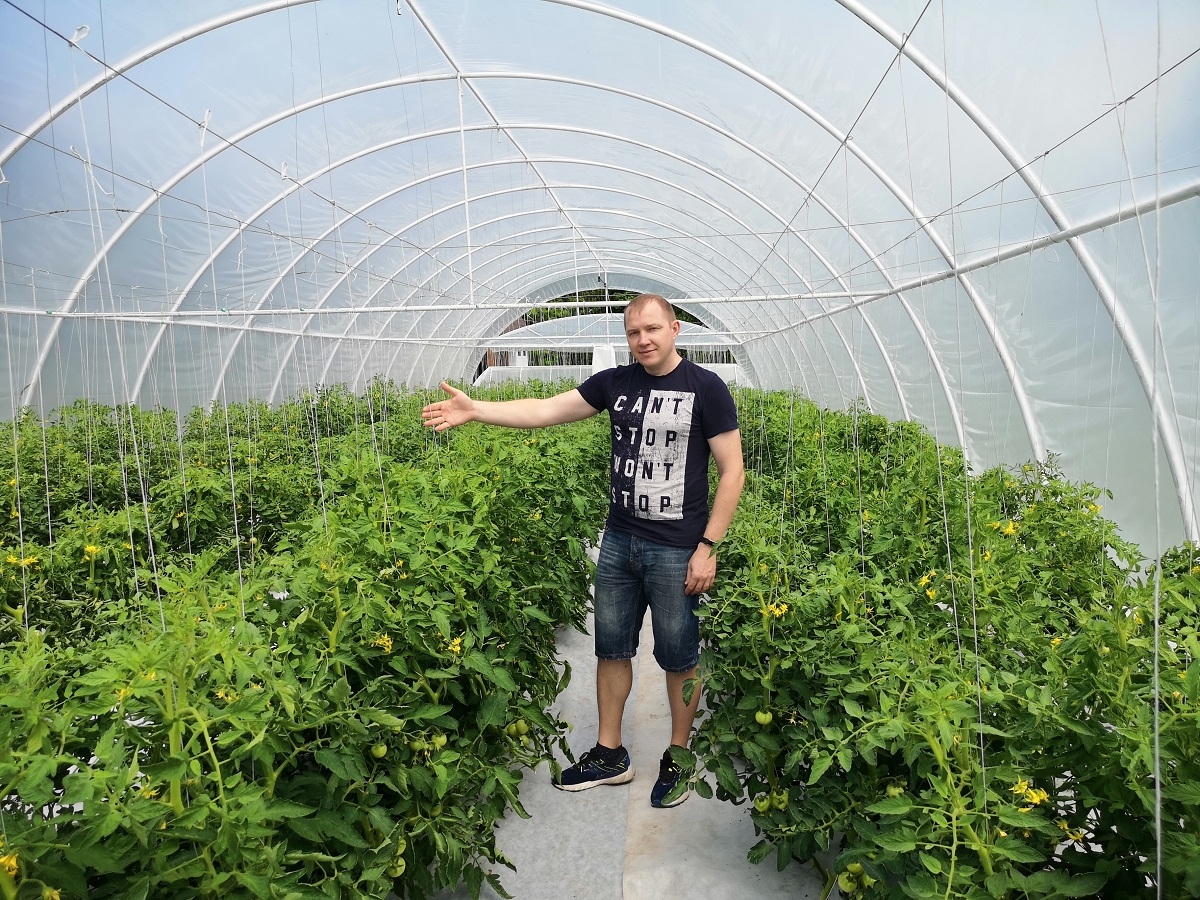Summer greenhouses: the mast-heave of the grower
For a long time, greenhouses were a tool for growing products in winter and spring, and with the onset of heat, it was time for open ground. The trend of recent years has been the use of ... summer greenhouses. What is their meaning and benefit for an entrepreneur, how much must be invested, what technologies and solutions must be applied to achieve a good result, says an experienced agricultural entrepreneur, director of Studenitsa LLC, postgraduate student of NUBiP Sergey Myrza.

The global trend, in which Ukraine has been going for about 15 years, is a general increase in the consumption of vegetables and more attention to their quality, taste, and appearance. The entrepreneur must see this need and look for an opportunity to satisfy it. This will help the transition from extensive agricultural technologies to intensive. First of all, this is the construction of a "summer" greenhouse.
Unlike spring crops, whose goal is to get an early harvest, the summer ones are to get a good, large, high-quality, and what is especially important - the predicted harvest. For example, when growing tomatoes in open ground, the yield will be 60-100 tons per hectare. At the same time, a high-quality, marketable crop can be obtained from 50-80 tons. And these are good varieties of tomatoes. In a summer greenhouse, from the same number of plants, you can collect from 180 to 300 tons of vegetables, of which 90% is a high-quality product. But the cost of a kilogram in the open field will be 2-4 UAH per 1 kg, and the cost in any buildings - from 6-8 UAH per 1 kg, depending on their manufacturability. If an entrepreneur plans to get an average of 200 tons of crops per hectare, he will have to invest 2 million UAH. Is it worth the candle?
The profitability of greenhouse vegetables will reach about 30-50%, ground vegetables - 10-100%. These are very interesting numbers, and they need to be "read" correctly. Ground vegetables are highly dependent on weather conditions, diseases, pests - that is, volatility. This is a kind of agro-casino. You can invest and get 200% of the profit, or you can go into the negative. The past five years have been disastrous for vegetable growers. Weather conditions this year are also far from desired. The conclusions are transparent.
The investment depends on the type of business you are creating and the income you want. Business (namely business, not self-employment of an entrepreneur) starts from 5000 sq. m. for 1 sq. m greenhouses of any type need to invest from 12 to 20 dollars. That is, for a small agricultural enterprise it will be 50-100 thousand dollars. What's interesting: the amount that will be invested is approximately equal to the turnover that will be achieved. And if the investment amount is divided by four, we get the approximate amount that we will earn per year. If an entrepreneur is satisfied with an annual turnover of 50 thousand dollars, 20 thousand profitability and about 10 thousand dollars of net earnings, then he should limit himself to this amount. If the ambitions are big, we recommend entering from the amount of 150-200 thousand dollars. In this case, earnings will no longer be 20%, but 25%. This is economies of scale. The larger the scale, the greater the earnings ratio. In addition, the larger the scale, the easier it is to develop a distribution channel. Another tip. When you invest, make cold money - frozen money. Leave up to 30% of the investment for unforeseen expenses.
Unlike spring greenhouses and the soil method, in summer greenhouses it is reasonable to grow those varieties of vegetables (for example, tomatoes) that will be more expensive in this group. Not regular red or cream, but pink, yellow, kumato, and so on. Their wholesale price in the summer will be 15-18 UAH, and if the prime cost is 7-10 UAH, then this is an application for a good entrepreneurial income. Of course, if you have built a distribution system.
After all, the second most important question for an entrepreneur after “how to grow” is “who to sell to”. His earnings directly depend on the answer. Sales opportunities are highly dependent on consistent quality and consistent product flow. If an entrepreneur wants to win his place on the supermarket shelf, he is simply obliged to switch to technological, precise production, which can only be provided by a greenhouse. No supermarket, no chain, no wholesale buyer, even just a retail store will accept products on an ongoing basis, if they are delivered for one week, they let them through for the second, and on the third they give the quality and type of goods that are strikingly different from the first. Potential sales channels for small agricultural enterprises are classic: supermarkets, wholesale markets, markets, networks, groups in Telegramm, Viber, etc., buyers.
As in the rest of the world, tomato is the most profitable vegetable crop. There are whole regions in Ukraine that are engaged in cucumber, there are huge areas for tomatoes. But there is no such thing as overproduction of these classic vegetables. Unlike niche cultures, which are now very fashionable and interesting for small businesses, but which do not have a mass consumer and are more difficult to find distribution channels. There are many niche and interesting crops, the same microgreen, greenery, mushrooms. This is a great way to make money if you have already formed a portfolio of clients - the same restaurants or supermarkets. But if you do not understand the distribution channels to the last kilogram, it is better to choose proven options. Even with cauliflower, zucchini, onions on a feather, you can get into a situation when the market stops and it is almost impossible to sell the product. Whatever the market situation, you will sell cucumbers and tomatoes.
Let's talk a little about practical innovations. It can be argued that another agrarian revolution is now underway. It is aimed at precision farming, precision work, SMART-agro. For a "greenhouse" entrepreneur, first of all, this is accuracy in terms of work and plant care. If you do not carry out certain work on time, let the care fail, “good chemistry” will not help.
The first necessary, albeit not very "aggro" gadget is a good smartphone. With its help, it is easy to carry out the programming of work, time planning of all stages. On which day to sow the seeds, on which day to plant the seedlings in the ground, when to do this and that. A regular Google calendar will notify you of every necessary action in advance.
To correctly calculate all these terms, there is no need to pay a salary to a full-time agronomist for a year. It is enough to find a good "freelancer" or a specialized company that will outsource you as a client. Online as part of the latest trends. There are also specialized groups on Viber and social networks, including those organized by seed producers as a marketing tool. There are experienced agronomists and producers in these groups. This is enough to find answers to all questions. Accuracy in processes is followed by their controllability and automation. There are several parameters most important for summer greenhouses that affect the yield, traditionally labor intensive, but easily retrofitted.
Greenhouse climate control. It is enough to buy a portable weather station xiaomi on aliexpress for 600-1000 UAH, a controller for data transfer, and all data from the station will be loaded into the gadget, and the entrepreneur will see the temperature and humidity without wasting time and effort, to which he can quickly respond. Two such stations are enough, on the street and inside. In addition to the current response, analyzing data from one season will allow you to plan tasks and actions for the next season.
Automatic ventilation. You can also take a solution from xiaomi. In general, this company has many solutions that can be integrated into the greenhouse. The programmed control unit will open / close the greenhouse itself, depending on the temperature and humidity. The issue price is 5-6 thousand UAH plus electric motors with drives. The whole system costs only 10 thousand UAH. It removes time-consuming and troublesome opening-closing processes. An entrepreneur should not waste time on this, and hiring staff is an absurd cost.
Watering automation. It is enough to put a tensiometer in the soil, which will transmit data on the dryness of the earth at different depths to the controller and then to a smartphone, and based on this data, make a decision on watering. It is also worth making a semi-automatic system into which you need to fill in the composition and then it will, upon a signal from the user, again from a smartphone, start the watering process.
Heating systems. Heating is more relevant for spring greenhouses, but in summer it can be used for individual crops. Nobody canceled the usual air "cannons", then their start-stop should also be adjusted from a smartphone, and a humidification system should be integrated into it (if the needs of culture).
Artificial lighting. This option is not available for small businesses due to the very high cost of electricity consumed. In summer greenhouses, this parameter is not key. By the way, often novice "greenhouses" are considering options with the use of solar panels. Calculations show that installing solar panels, even for lighting, at least for heating and other needs, is unprofitable. It is expensive, time consuming, and does not pay off in any way. If ordinary electricity can be connected to the greenhouse, nothing else should be invented. If there is nowhere to connect around your site, and this decision is the only way out - then yes, it will be justified by the lack of alternatives. Installing small, separate battery panels to keep controllers and low-cost hardware running is smart.
The listed solutions are very simple and affordable. However, farmers and small agricultural enterprises often take care of plants and control the process in a "manual" mode, using hired labor. Entrepreneurs do not sleep at night and guard the harvest. But only 2-3 thousand dollars is enough to make a summer greenhouse technologically advanced, automated, corresponding to today's needs.
As for innovations, within five years there will be enough of them in the greenhouse economy and it is necessary to prepare the soil for them right away. Over time, a decrease in labor costs and an increase in controllability will be mandatory trends. The development will definitely go through the maximum automation and mechanization of processes. So you need to predict in advance where and how manual labor can be removed. For example, to plan the ergonomics of an object so that a robot planting seedlings and a harvesting robot can pass by, and in the greenhouse, provide a room for sorting and loading goods, of course, with an automatic line and sorter robots.
The conclusion is as follows. Summer greenhouses for growing vegetables in modern conditions are a must-have compared to open ground. Only the predicted amount of marketable crop will help build sales. The predicted amount of harvest with the right sales will allow the entrepreneur to predict his financial flows and get the expected profit, not disappointment.















